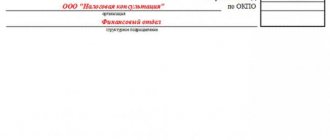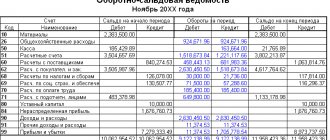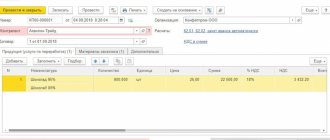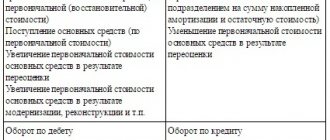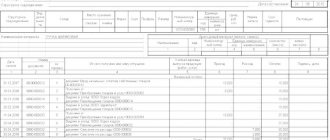In this article we will analyze the concept of goods and materials, what they are, what types of products belong to this term, how the issue is related to accounting, what checks need to be carried out.
We will also use specific examples to see at what stages of the production cycle such elements may be present. It is often assumed that this term refers to a certain stock of property, which is reflected in accounting. But in fact, the concept is much broader and includes many different objects.
Before starting, I would like to note that, contrary to popular belief, this area is, in principle, controlled by a mass of laws, and not by one specific norm. These are the Federal Law “On Accounting”, and acts of the Ministry of Finance, and presidential decrees.
What is inventory material, decoding
First, let's look at the definition. It means all the assets of a particular enterprise that participate in the turnover process and are profitable. This is both a product and consumables that accompany the sale. So, this includes a roll of bags, which is used in grocery stores to buy vegetables or bulk products. It itself has no value, is transferred free of charge, but is aimed at simplifying the sale of certain objects. A kind of catalyst, also exhaustible. It is part of working capital. But the machine on which products are produced does not belong to the cycle, but is an element of direct capital. And it is not included in the concept being discussed. In addition, this term may also include liability if it is income-oriented. For example, a credit obligation of a counterparty.
Let's look at how the abbreviation TMC stands for inventory items. It immediately becomes clear that, first of all, these are products that are currently being sold. As well as other objects that either only accompany the product or are its unformed form. Unfinished product. But it still belongs to the company’s property and must also be subject to accounting and control. For example, a car that has not yet acquired optics (headlights) remains a car. It cannot be sold, but it is already important to the organization. Although it will be sent for sale only after the completion of the production process. For now, this is just a particle of the future product.
So, TMC (abbreviation decoding) is what it is: values of a commodity nature in the first place, but at the same time also of a material nature. And this means that intangible assets, copyrights, trademarks, programs, patents - all this no longer applies to this area.
Accounting
Industrial inventories include assets whose service life does not exceed one year. PBU 6/01, regarding fixed assets, determines that inventories cannot have a value exceeding 40 thousand rubles. – this is the limit on inventories in accounting.
PBU 5/01 provides the right to independently determine in which units the accounting of inventories will be organized: by item numbers, batches, groups and in any other way that the company deems necessary for the reliability of the information.
This asset is reflected in the accounting system at its actual cost, which includes the seller’s price, consulting services of third-party companies, transport and any other costs directly related to the acquisition of the asset (clause 6 of PBU 5/01).
Inventories can be reflected in the reporting at the contract price, with further clarification of the data to actual ones in two cases (clause 26 of PBU 5/01):
- purchased goods are on the way;
- MPZs are pledged to the buyer
The actual price is not affected by VAT. This tax is allocated as a separate posting.
General, or synthetic accounting, assets are reflected in accounts 10, 43, 41, affecting, respectively, materials, finished products, goods. Subaccounts detail this information taking into account the classification of inventory items. For example, information on account 10 can be detailed by subaccounts: 10/1 “Raw materials and materials”, 10/3 “Fuel”, 10/4 “Container”, 10/5 “Spare parts”, 10/9 “Inventory and household supplies” and etc.
The most important element of analytical accounting is properly organized warehouse accounting of inventories - receipts and releases into production, for household needs, for sale.
Capitalization and release are carried out according to primary documents, for example:
- consignment note TORG-12, consignment note for the transfer of products to the warehouse MX-18;
- receipt order M-4 (or act M-7, if there is a deviation in the actual volume and invoice data); TORG-1 act upon acceptance of finished products;
- invoice for internal movement M-11, limit-fence card, invoice, consignment note, consignment note;
- other forms adopted in the accounting policies and legislation of the Russian Federation.
All movements of inventory items are recorded in the warehouse record card (book), the goods and finished goods log book.
Control in the accounting department is carried out based on reports from materially responsible persons on the movement of inventory items, commodity reports, and inventory records. As a rule, unified forms of documents are used, but legislation does not prohibit the development and use of a company’s own forms.
Analytical data is collected in accordance with accepted accounting units.
What does this mean in accounting?
Since it is both a means of production and a product for sale, the category needs strict control. This is actually the main resource of the company, which it appeals to. In accounting, the term has a broad interpretation. According to one version, this is that part of the company’s property that is directly involved and responsible for the process within the organization. According to another, this is, in principle, the property share of an economic entity, which is necessary for normal activities, expansion and development of the enterprise. There is a third view of what goods and materials are and what belongs to them: this is a tool of labor, which in its material form constitutes a future product. And it necessarily belongs to the production cycle.
That is, there are narrower and broader interpretations. But the importance of this category is brought to the fore everywhere. Equally, the importance of scrupulous accounting is fundamental. This is why there are a lot of different checks. And in particular, the key one is inventory.
Accounting for receipt of materials at actual cost (postings, example)
If inventory items are accepted for accounting at actual cost, then they are immediately debited to account 10 at the cost indicated in the supplier’s documents. If the organization is a VAT payer, then the tax amount is allocated for reimbursement from the budget to a separate sub-account. Postings when accounting for materials at actual cost are as follows:
| Debit | Credit | Operation name |
| 60 | 51 | The cost of received goods and materials was paid to the supplier |
| 10 | 60 | Inventory and materials are accepted for accounting at actual cost excluding VAT |
| 19 | 60 | VAT is allocated from the cost of inventory items |
Transportation and procurement costs (TPC) when purchasing materials in accounting can be taken into account in different ways:
- Can be included in the actual cost of materials on account 10.
- May be reflected in a separate subaccount of account 10.
- Can be taken into account on account 15.
The organization chooses one of these methods of accounting for transportation and procurement costs and reflects this in the accounting policy order
Example of accounting for receipt of materials upon purchase
| The organization Alpha LLC purchased 5,000 cubic meters of parquet for 600,000 rubles. including VAT 91,525. For delivery they paid 6,000, including VAT 915 rubles. 3,000 cubic meters of parquet were put into production. These transactions must be reflected on the balance sheet. Note: (How VAT is calculated from the amount can be found in the article: “How to calculate VAT. VAT tax rates.”). Transport and procurement work is accounted for on account 10 of the TZR subaccount. |
Postings for accounting for receipt of materials upon purchase
| Sum | Debit | Credit | Operation name |
| 600000 | 60 | 51 | Paid the cost of parquet |
| 508475 | 10 | 60 | Parquet was capitalized excluding VAT |
| 91525 | 19 | 60 | VAT allocated |
| 6000 | 60 | 51 | Delivery paid |
| 5085 | 10 subaccount TZR | 60 | Parquet delivery costs taken into account |
| 915 | 19 | 60 | VAT allocated |
| 360000 | 20 | 10 | Materials written off for production |
| 360000 | 20 | 10 subaccount TZR | TZR written off for production |
TZR are written off once a month in one transaction. To determine the amount of write-off of transportation and procurement costs, the following ratio is determined:
Accounting for inventory items at an enterprise
There are two main points when such values are taken into account. Fixation occurs upon receipt and upon departure. That is, first of all, the posting of goods is subject to accounting, which for now may only represent material, raw material for future processing. All parish nomenclature, sales and purchase agreements, supplies, and accompanying documentation are recorded. Moreover, even if the source was not a third-party contractor, a supplier, but the company itself. After all, many factories have a very long production chain. When products come from one object to another in a more processed form. And all sites are part of a single enterprise.
Loss is the second stage, which also needs to be fixed. A similar outcome is possible in two variations. The first is product sales. That is, the creation of the object was successfully completed, and it went to the buyer, be it a legal entity or an individual, for a fee. The second option is loss due to various circumstances: damage, expiration date, defects, force majeure circumstances, theft in a warehouse or loss without identified reasons.
What is included in goods and materials
First, let's go through the general categories. Let's look at the varieties:
- Objects for implementation. The finished ones, which no longer require any processing, can only be sent for sale.
- Related materials necessary to complete the creation cycle, but not part of it. This is also the company's property, which must be scrupulously controlled.
- Raw materials, necessary resources. Sometimes these are just constituent elements, in other cases, this is, in principle, the entire basis of the created object. In fact, there is no serious difference for accounting.
Now let's move on to a more specific classification. And let's see what inventory items are:
- Inventories used to create new products.
- Raw materials.
- Fuel.
- Containers, consumables.
- Spare parts.
- Directly products for sale.
Species diversity
There are a huge number of classifications from various sources. But in order to most accurately understand the essence, it is enough to distinguish three main groups.
- Raw materials. This is the part of material assets that will be completely used for processing. However, these funds have not yet participated in the production process.
- Unfinished materials. Here the degree of readiness is not determined. This could be just the frame of an equipment or product, or, on the contrary, an almost completed item that is missing a couple of touches. The main criterion is that the object cannot yet be realized.
- Finished goods. You can send it to the counter or to your counterparty right now.
To make it clearer what is included in inventory, let’s give an example. Milk received from a supplier to create ice cream is still only a raw material. But if it has undergone at least some processing, it is already unfinished material.
Let us consider further in more detail.
Raw materials
Can only be used by an organization to create a product. This is the material material from which the product will consist in the future. Moreover, it becomes clear that as a result of work there is a lot of waste. And the final product will be much less than the initial one. Moreover, often a product item is produced in only one type. But the raw materials supplied are varied. To create a car you need steel, plastic, microchips and much more.
And inventory assets are the total part of various products, regardless of the specific stage at which they are used.
Unfinished production
As has already become clear, this is the most difficult group. After all, keeping records of these objects is extremely problematic if you give your name at each stage. Roughly speaking, they are constantly in process, changing somewhere every day, somewhere every hour. Now this is just the frame of the product, tomorrow it will be overgrown with mechanisms, then plastic and packaging. Tracking at each stage is problematic. Therefore, everything that does not belong to basic raw materials, and is also not a product that can already be sent to the counter, belongs to this group.
Finished Products
As we have already found out, goods and materials are what is included in the cycle. And as a result, many mean that they will no longer participate in production. Which can only be used. But this is not always true. After all, companies, in principle, often specialize in unfinished products. And if a given company at the end of the cycle only has a chip for a cell phone, this does not mean that it belongs to unfinished products in accounting during verification. And it doesn’t matter that the buyer will then perform many manipulations with it before turning it into a full-fledged smartphone.
Methods for valuing inventories
As already mentioned, goods and materials (explained at the beginning of the article) is a term that is used to define materials owned by an enterprise. They may also be intended for sale to consumers or used in the production of their own products.
There are several most common methods for assessing them:
- Piece estimate. Each unit of goods is counted individually.
- First Inventory Method, otherwise known as First In, First In (FIFO). It is based on the assumption that those inventory items that are in inventory the longest are the ones that are sold or used the fastest.
- Last Inventory Method, second name - “Last in stock - first in production” (LIFO). The estimate is based on the assumption that the last items purchased will be the first to be sold.
- Average cost method. In this case, there is an assumption that all inventory items are mixed in a random sequence, and the sale occurs at random.
- Moving average technique. Here it is assumed that the flow of goods is randomly mixed with each new arrival of goods, and their sale occurs in the same random way.
Assessing values in an enterprise
One of the most important tasks during capitalization is to identify the cost factor. It will be necessary to focus on it in the future in a lot of different processes. But in this case the task becomes somewhat more complex. According to general rules, it is customary to focus exclusively on the physical cost of an object when it comes to inventory items. But its identification will depend on the source of receipt. And the difficulty of verification will also directly correlate with this factor.
Let's look at how this technique works using a table to make everything as clear as possible.
So, how are trade and material assets valued?
| Source | Methods for identifying costs |
| Purchased from the supplier when paying according to the standard scheme in monetary units | The entire amount of money that was allocated for the purchase is recalculated, and this includes delivery, if it had a cost. But VAT is excluded from the total amount |
| Which the company produced on its own | A new term appears here - MPZ, we will touch on it later. These are expenses aimed directly at the production process. |
| Accepted free of charge, as a result of promotions, discounts, gifts | It will be necessary to identify the current market price at the time of capitalization and focus strictly on it. If the determination of cost also involves a certain level of costs, they are also recorded in the cost price. |
| Directly allocated to capital by the founders | The price factor is identified using the recommendations of the founders. |
| Received as a result of barter | The full cost of the spent property is revealed. If there is no way to accurately determine the figure, then you should rely on the market price of the assets already received. |
| For sale | Depending on the regulations of the company itself. There are two options, either look at the price of receipt, or at the price at which it is planned to sell goods during business activities. |
Documentation in inventory accounting
To carry out an inventory, the head of the company forms an inventory commission, the composition of which is approved in an order in the form INV-22.
Each inventory is recorded in the journal using the INV-23 form.
Before the start of the verification procedure, the responsible persons confirm in writing that all accounting documents have been transferred to the inventory commission.
For each type of values and obligations, there are separate inventory forms:
- INV-1 - for OS;
- INV-3 - for goods and materials;
- INV-4 - for shipped goods;
- INV-6 - for goods and materials in transit;
- INV-15 - for cash;
- INV-16 - for securities and BSO;
- INV-17 - for checking settlements with counterparties.
Inventories record information about the property being inspected: name, quantity, condition, inventory numbers, etc. Data in the inventory is entered manually or using computer technology. Marks are not allowed.
If the audit reveals a deviation of the accounting data from the actual availability of property, the commission creates matching statements using the following form:
- INV-18 - for OS;
- INV-19 - for inventory items.
Such statements are drawn up in two copies: for the accounting department and for the financially responsible person, who must explain in writing the reason for the discrepancies.
Discrepancies can be of the following types:
- Surpluses are credited to the account. 91 in correspondence with the property accounting account at market prices (clause 29 of the Methodological Instructions for the accounting of inventories, approved by order of the Ministry of Finance of the Russian Federation dated December 28, 2001 No. 119n).
- The shortage may be within the framework of natural loss - then it is charged to cost accounts. Excessive loss is written off at the expense of the guilty parties. If there are none or the court refuses to recover damages, then the shortage is written off as production costs (paragraph 5, clause 5.1 of the Methodological Instructions for Inventory of Property and Financial Liabilities).
Attention! Natural loss rates can be used only if they are approved by legislative acts of the relevant government agencies. The accountant must write off shortages or damage to valuables in excess of the norms on the basis of a court decision (in the absence of the perpetrators or refusal to recover from the guilty person) or a conclusion on damage to property issued by a specialized organization (clause 5.2 of the Guidelines for the inventory of property and financial obligations).
During inventory, misgrading may be detected. Then the surpluses and shortages are counted against each other, and the responsible persons provide the commission with written explanations. The offset can be carried out only for the same audited period from the same financially responsible person for the same values (clause 5.3 of the Methodological Instructions for Inventory of Property and Financial Liabilities). If the surplus is not enough to cover the shortage, then the procedure is similar to that when a shortage is detected.
Important! In tax accounting, a credit for regrading cannot be made (letter of the Ministry of Finance dated May 23, 2016 No. 03-03-06/1/29309).
The results of all inventories are recorded in the statement of results in the INV-26 form.
The need for inventory
While we were analyzing what inventory materials mean, we often mentioned this particular type of verification. And for good reason, because it is fundamentally important in this area.
The meaning of inventory is the constant control of all current assets. Often this involves planned control, which is designed to verify the actual availability and records in documents. The manager personally hands over documentation and inventories that indicate the number of balances at the moment. And the commission he formed is conducting an inspection. They identify whether there are any shortcomings or, on the contrary, an unaccounted surplus.
In addition to scheduled inspections, an inventory is often carried out when there is a change in responsible persons, company reorganization, or various types of emergencies, such as fire. In addition, if theft was detected in a warehouse, then the inventory must calculate the volume of the criminal act.
It is worth understanding that with a large turnover of assets, this procedure is lengthy and very difficult. You can simplify it to a minimum using software solutions from Cleverence. They not only turn a routine audit into a quick and easy action for employees, but also eliminate excess human costs. After all, just one employee with a smartphone, or better yet, a TSD, is enough, because the phone is not always reliable, and the data collection terminal is much more secure for working, for example, in a warehouse, to carry out the procedure. In addition, various types of solutions are offered: both individual offers that are personalized specifically for the type of business activity and all the features of the “internal kitchen” of a legal entity, and packaged solutions for any company.
Inventory stages
The inventory process itself consists of several stages. The first one is preparatory. Everything is simple here. This is the preparation of valuables for recount, as well as the preparation of all documents, compiling lists of all financially responsible persons, determining the methods and timing of the event.
The second stage is actually checking the actual availability of material assets and drawing up inventory lists. It should be noted that acts and inventories are compiled according to standard forms and are primary accounting documents. They can be written by hand or printed. In any case, they must be correctly formatted.
The inventories indicate inventory items, their quantity and cost. Errors made during the preparation of statements must be corrected in both copies. An incorrect entry is crossed out with one line, and the correct value is written above it. All corrections are agreed upon between members of the commission and financially responsible persons. You cannot leave blank lines in inventory records (if there is space left, dashes are added). The statements are signed by all members of the commission and financially responsible persons.
If the re-accounting was carried out due to a change in responsible persons, then the act is signed at the end by the new materially responsible person, confirming that he accepted the inventory items.
The third stage - a very important one - is the analysis of inventory data and reconciliation of information with what is shown in accounting. In essence, the difference between the actual presence of values and accounting data is revealed. Then management looks for reasons for discrepancies, if any are found.
Well, the fourth stage is the correct preparation of documentation. It is at this stage that it is necessary to bring the inventory results into strict compliance with accounting data. Financially responsible persons guilty of incorrect accounting are punished.
This is how an inventory of goods and materials is carried out. The decoding of this concept and the essence of the procedure are already known to you. We also looked at the stages of holding an event that is so disliked by many (and almost everyone). Now let's talk about what should actually be classified as inventory items. Is all property valuable? What methods of estimating inventory materials exist today?
Display in accounting
Primary documentation and other accounting registers constantly record the state of balances at the beginning of new periods. Changes and edits are made only due to the identification of inconsistencies during inspections.
If there were no deviations, then arrival and departure are processed as usual in the form of balances for two key dates. This is the beginning and end of the year. It is considered inappropriate to withdraw the full balance more often. But this does not mean that data is not collected in other periods. It just doesn't display a full report.
Differences between inventories and inventories
Inventory is inventories. We have already mentioned them above. And modern sources on the network, indeed, are trying to identify some difference between them. But all such opinions are wrong. After all, in reality, they are completely the same thing. The difference is simply in terminology, nothing more. And also in the fact that now MPZ is considered a more modern option, which is more often used in young companies, startups and new projects. Often, the MPZ does not take the goods themselves, but only raw materials, materials and other consumables.
TZR when purchasing goods
A significant part of the costs in the economic activity of an enterprise is material costs. The amount of income tax depends on their correct accounting. To form the tax base, it is necessary to use the Tax Code, according to which not all costs incurred can be included in expenses.
In tax legislation, expenses are recognized as economically justified (aimed at making a profit) and documented (documented in accordance with the law) expenses incurred by the taxpayer. They share:
- for the costs of production and sales of products;
- non-operating expenses.
Material costs are included in the group associated with production and sales and are described in detail in Art. 254 Tax Code. These include everything that has a material and monetary characteristic, is used in the production of products and the provision of services, as well as all costs aimed at sales: packaging, transportation, storage, etc.
When writing off materials and raw materials into the cost of production, an enterprise has the right to independently choose and apply one of the methods (clause 8 of Article 254 of the Tax Code of the Russian Federation):
- at the cost of receipt of the unit;
- at average cost;
- according to the FIFO method - write-off according to the order of arrival.
The methods for applying these valuation methods are similar to those used in accounting and are described in paragraphs. 16-19 PBU 5/01 “Accounting for inventories” and paragraphs. 73-76 Methodological guidelines for accounting of industrial production (order of the Ministry of Finance of the Russian Federation dated December 28, 2001 No. 119n).
PBU 5/01 determines that TZR are included in the actual cost of materials (clauses 6, 11). Paragraph 83 of the guidelines allows the use of three methods of recording TKR in terms of purchases. The company is instructed to choose one of the methods below and include it in the accounting policy of the enterprise.
- The 15th account “Procurement and acquisition of materials” is used for reflection.
In addition to the mentioned 15th account, with this method and when applying accounting prices, the 16th account “Deviation in the cost of material assets” is also used. Reference prices can be taken from the following categories:
- negotiated prices (they should not take into account associated costs for procurement and delivery);
- prices in force in previous periods;
- planned prices;
- average prices valid for a certain group of inventories.
| The essence of the recording | Dt | CT |
| We record the cost of materials received based on the primary documents received from the partner (at purchase prices) | 15 | 60, 71, 76 |
| We record the technical requirements based on the primary documents received from the supplier (clause 85 of the guidelines) | 15 | 60, 71, 76 |
| We receive materials using discount prices | 10 | 15 |
| We write off the amount formed as a positive difference between the actual price and the accounting price | 16 | 15 |
| If a negative difference is formed, the entry will be reversed | 15 | 16 |
| We record the write-off of materials for production using the accounting price | 20, 23 | 10 |
| We record the difference between the actual and accounting value of the inventories transferred to the buyer, if this difference is positive. Otherwise, the same posting is reversed. | 20, 23 | 16 |
When forming the above table, in addition to those already described, the following accounts were used:
- 10th - “Materials”;
- 20th - “Main production”;
- 23rd - “Auxiliary production”;
- 60th - “Settlements with suppliers and contractors”;
- 71st - “Settlements with accountable persons”;
- 76th - “Settlements with various debtors and creditors.”
K = (Off0 Off1) / (M0 M1) × 100,
K is the size of the deviation as a percentage;
Deviation0 - the size of the deviation at the beginning of the month (remainder);
Off1 - the size of the deviation accumulated during the month;
M0 - volume of materials at the beginning of the month in accounting prices;
M1 - volume of materials received during the month at accounting prices.
Off2 = K × M2,
Off2 - the size of deviations that can be written off as expenses;
M2 is the volume of materials at accounting prices, which is written off as expenses.
- For reflection, a special sub-account is used on the 10th account “Materials”.
| The essence of the recording | Dt | CT |
| We reflect the cost of materials at purchase prices based on primary documents from the partner | 10 | 60, 71, 76 |
| We reflect the technical requirements on the basis of primary documents from the partner (clause 85 of the guidelines) | 10, sub-account “TZR” | 60, 71, 76 |
| We write off materials for production | 20, 23 | 10 |
| We write off inventory items in proportion to the cost of materials generated at the end of the month | 20, 23 | 10, sub-account “TZR” |
The above formulas can also be applied in this case. In this case, the selected calculation method should be approved in the accounting policy.
- TZR are directly included in the actual cost of materials.
This method is available only to those companies whose list of materials used is small and there are groups of materials that occupy a predominant volume in their total quantity. In other words, if the TRP falls on such inventories, then such expenses will be included in the cost of a unit of material.
Also look for information on materials accounting in the article “Accounting entries for materials accounting.”
When purchasing goods, appropriate transportation costs can also be taken into account in different ways, which depend on what kind of activity the company is engaged in.
Thus, trading companies are allowed to choose an accounting method from the following list:
- TZR are included in the cost of goods (clause 6 of PBU 5/01): Dt 41, subaccount “TZR” Kt 60.
If account 15 “Procurement and acquisition of material assets” is used to record goods, then the entry will be as follows: Dt 15 Kt 60.
- TZR are included in the costs of selling goods (clause 13 of PBU 5/01), with the following costs:
- are scattered between those goods that are sold and those that remain in the warehouse (in the description of account 44, chart of accounts approved by order of the Ministry of Finance of the Russian Federation dated October 31, 2000 No. 94n),
- written off to cost in full: Dt 44 Kt 60.
At the end of the month, sales-related expenses can be written off to cost. The entry will be as follows: Dt 90, subaccount “Sale expenses” Kt 44.
The chosen accounting method must be included in the accounting policy of the enterprise.
In the above entries, in addition to those already mentioned, the following accounts are given:
- 02nd - “Depreciation”,
- 41st - “Goods”,
- 44th - “Sales expenses”,
- 70th - “Settlements with personnel regarding wages”,
- 69th - “Calculations for social insurance and security”,
- 90th - “Sales”.
If a partial write-off is used, then the accounting policy will need to include a method that the company will use when dividing inventory between goods sold and those that remained stored in the warehouse. The regulations do not provide guidance on which method to choose in different circumstances. That is, companies are free to choose it themselves.
K = (TP0 TR1) / (T1 T2) × 100,
K is the average percentage of goods and materials that fell on inventory balances at the end of the month;
TP0 - transport costs, which correspond to unsold inventory balances at the beginning of the month;
TP1 - transport costs incurred in the current month;
T1 - the cost of goods that have already been purchased and sold in the current month;
T2 - the cost of goods that were purchased but not sold at the end of the month.
TP2 = K × T2,
TP2 - transport costs that fell on unsold inventory balances at the end of the month;
T2 - the cost of goods that have already been purchased but not sold at the end of the month.
Non-trading organizations have the right to take into account transportation costs as sales expenses. This definition is contained in paragraph 227 of the guidelines for accounting for inventories, approved by Order of the Ministry of Finance of Russia dated December 28, 2001 No. 119n. Non-trading organizations should be considered those companies that, in addition to trading operations, carry out other types of economic activities.
Companies included in this category have the right to choose whether to spread costs between the cost of goods already sold and inventory balances. However, there are also some recommendations in this regard, contained in paragraph 228 of the guidelines. It is proposed to distribute expenses if:
- TZR exceed 10% of sales revenue,
- TZR is uneven throughout the year.
In addition, TZR are also taken into account in the actual cost of acquired fixed assets, as read in the article “Rules for keeping records of investments in non-current assets.”
The following options for accounting for delivery costs are possible:
- If the delivery price is included in the price of the product.
This option most often occurs when the goods under the contract are delivered by the supplier to the buyer’s warehouse and the delivery price is not highlighted separately in the primary documents.
Transport costs in these circumstances are selling costs. The entry for the corresponding transaction in accounting will be as follows: Dt 44 Kt 60, 76.
Such expenses should be written off to cost in full at the end of the month. The entry will be as follows: Dt 90, subaccount “Sales expenses” Kt44.
- The delivery price is shown separately from the cost of the product.
If the delivery price is highlighted in the contract for the purchase of goods, this means that the supplier intends to receive payment for delivery separately. In this case, there is revenue for transport services. Costs associated with delivery must be reflected in the following entry: Dt 23 Kt 02, 10, 70, 69.
Subsequent write-off of expenses: Dt 90, subaccount “Cost of transport services” Kt 23.
In fact, accounting for inventory items largely depends on their type. Postings for accounting for transactions with materials are very different from postings for transactions with goods and finished products. Primary documents for accounting for inventory items are also drawn up depending on what type of inventory items we are talking about. Let’s say right away that an organization can develop forms of primary documents independently and approve them by order of the manager. Or it can use unified forms approved by Rosstat. Below we provide the form numbers of such unified documents.
To account for goods in accounting, account 41 of the same name is used. The debit of the account reflects the receipt of goods, and the credit reflects write-offs due to sale or for other reasons (Section 5 of the Methodological Guidelines for Accounting for Inventories, approved by Order of the Ministry of Finance dated December 28, 2001 N 119n). When goods are received by an organization, as a rule, a receipt order is drawn up in form M-4.
